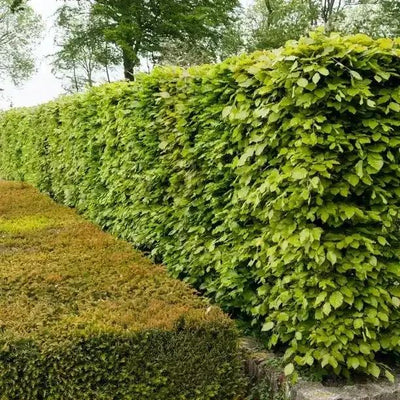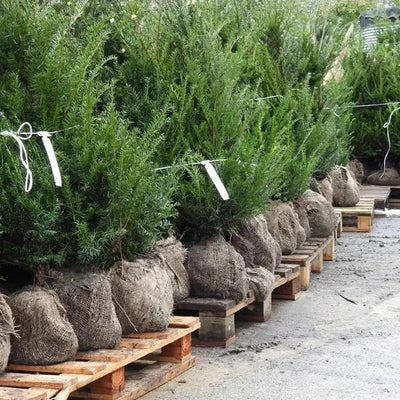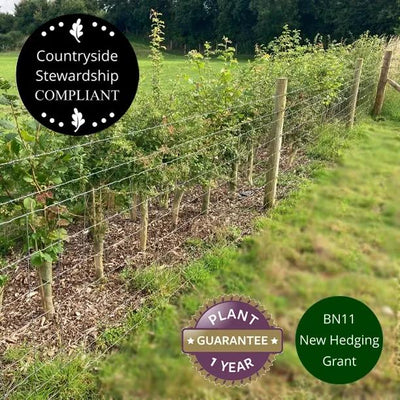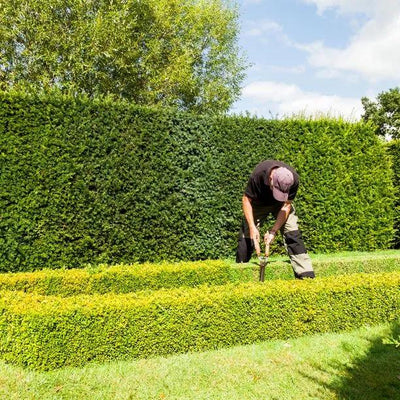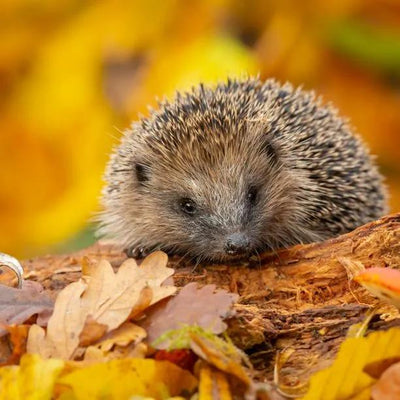Hedge Plants and Sapling Trees
Buy Potted Plants & Hedge Troughs Now For October Delivery
Pre-Order Bareroot Plants For 2025/26 Winter Planting Season
You can buy all the native hedge plants, sapling trees, and a wide range of ornamental varieties from us.
Hedging plants are cheaper, longer lasting, and much easier to install than a fence.
Hedgerows provide privacy and structure to your garden, protection from the elements, a habitat for wildlife, and an ornamental framing of foliage and flowers for your lawns and flower beds.
What is so good about bareroot hedging?
The majority of UK hedging is planted bareroot. For many, buying plants with no soil around the roots sounds wrong, but the strong field grown stock transplants so well because they're sleeping in winter, minimising stress.
While out of the ground, plants are kept in ideal cold, humid conditions until picked, quality-checked, and sent by next-day delivery.
Bareroot hedge plants are, compared to pot grown equivalents:
Cheaper
Faster growing & better establishing
Weigh much less = easier to handle and plant
More eco-friendly, plastic free cultivation
Wider selection available
Only delivered November-March
Some plants or larger sizes only come in pots. Some popular species are sold bareroot in winter and potted the rest of the year.
Where you have a choice, bareroot is better.
To add interest to a new hedge or woodland, you cannot beat a range of garden bulbs.
Our healthy, high-quality stock is grown well, lifted regularly so it spends the least time in transit, double-checked for quality, and kept in proper cold-store facilities before packing.
When your order is ready: your mail order hedge plants are delivered by next working day courier (not the next working day after ordering!)
Friendly support: if there is anything wrong with your plants when you inspect them, Contact Us within 5 working days
All bareroot plants are covered by our Refund Guarantee, so you can give them a whirl with complete confidence.
What are the cheapest hedge plants?
Bareroot is always cheaper than pot grown. Small sizes are obviously cheaper than large, and tend to perform even better.
Top 4 cheapest deciduous hedge plants:
Top 4 cheapest evergreen hedge plants:
For larger projects, mixed hedge packs offer the best value per plant.
Choosing Which Size Hedge Plants to Order
Many hedge plants are delivered in sizes ranging from little 40/60cm tall unbranched 'whips', up to almost two metre, bushy specimens for the most popular species.
If you are in a hurry for privacy and need instant impact, then of course pick the biggest size that fits your budget.
If you are filling gaps in an existing hedge, large size replacements are usually better, but small plants are easier to slide into soil full of roots. Inspect the ground well and test getting a spade or pickaxe down along it.
Smaller plants have several advantages
Cheaper
Easier to plant
Establish well because they are dug up with most of their roots intact
Need less water in their first summer (but watering is still essential in dry weather)
Can be clipped attentively to ensure a bushy base & dense growth
So Which Size Hedging Should I Order?
Farmers and other large scale hedge or forestry projects prefer plants 40/60cm tall: it's the minimum required size for Countryside Stewardship hedging, and has the best success rate in field conditions. Conifers for forestry typically have to be sold a bit smaller, e.g. 20/40cm tall for a Sitka Spruce.
Many home gardeners choose 60/80cm tall as a great compromise between price, size, and waiting time until you get a mature hedge.
Plants over 80cm tall are good for creating privacy ASAP, filling gaps in mature hedges, and when they suit your budget. Remember, big plants need more water in their first year to thrive. Rootballed Yew is the biggest hedging we deliver, along with Instant Hedge Troughs.
Choose the Best Hedging for Me
By default, people plant evergreen hedges or beech around their homes for privacy and year round interest, and rugged, deciduous native plants everywhere else.
Most popular hedge plants lists:
More Useful Hedge Plant Lists:
What plants can't I use in a hedge?
Trees like Birch, Oak, Sycamore, Rowan, and Wild Cherries are sold as hedge-sized saplings because they're planted in country hedges to grow as trees above the hedge line, not clipped with it.
On their own they produce unsatisfying hedges, especially in winter when bare branches provide little screening. Surrounded by solid hedge plants like Hawthorn and Blackthorn, they look fine.
If growing mixed native hedging with hedgerow trees, use tree guards so their tops aren't trimmed with the hedge.
Hedging With Berries: provide extra interest & wildlife value, and several soft fruit bushes can be grown as / inside hedges as a treat beside a gate.
When and how do I plant hedging?
Bareroot: November to March. Pot grown: any time except frozen soil.
See our step-by-step guides:
How many hedge plants per metre?
Standard spacing for most hedging:
Single row boundary hedge: 3 plants per metre (33cm apart)
Double row stockproof: 6 plants per metre, rows 45cm apart
Formal hedges: 3 per metre (boundary), 2 per metre (interior)
Box edging: 5 plants per metre (20cm apart)
For detailed spacing by plant type and purpose, see our complete hedge spacing guide.
Aftercare
New hedges need proper care in their first year to establish successfully:
Water twice weekly in dry weather - establishing plants are on "life support"
Keep weeds clear for 75cm either side - weeds kill more hedges than rabbits
Mulch annually when soil is moist - dramatically boosts growth rate
Firm soil after frost to prevent frost heave
Record losses for replacement next season
For complete first-year care instructions including mulch options, watering schedules, and protection tips, see our hedge aftercare guide.
Hedge Trimming
Trimming is essential for dense, bushy growth from base to top.
Mixed country hedging: Cut back to 15-20cm immediately after planting to force low branching. Reduce new growth by 50% the following winter, then trim lightly each year until mature.
Formal hedging: Trim lightly - don't cut the leading stem of Yew/conifers until desired height reached. Mature hedges need 1-2 cuts per year (Beech/Privet twice, Box/Yew once).
Hedgerow trees: Plant like hedge plants but only prune off lowest branches to encourage a single trunk. Use tree guards so tops aren't trimmed with the hedge.
Hedge laying: Used to regenerate old country hedges. Well-maintained hedges won't need laying for 50+ years, though you could lay from year 5 onwards for practice.
For detailed trimming instructions by hedge type:
What is the difference between an ornamental shrub, a hedge plant, and a sapling tree?
Mainly their intended use! Most hedge plants are sapling trees, sold at ideal starting sizes for hedge use.
A beech hedge plant left to grow naturally becomes a normal beech tree, not a hedge.
Key differences:
Hedge plants (this page): mostly bareroot, trimmed 1-2x yearly for dense, functional barriers- Ornamental shrubs: mostly potted, pruned lightly (if at all) for flowers
Sapling trees: unsuitable for clipped hedges (Oak, Sycamore) - fine for tall screening, unsatisfactory when trimmed regularly
Natural overlap exists: Box can be low edging, formal hedge, or eventually a tree. Dogwoods work in country hedges or as colorful border specimens.

 Secure, One-Tap Checkout
Secure, One-Tap Checkout
 Hand Picked, Delivered to Your Door!
Hand Picked, Delivered to Your Door! 1 Year Bareroot Guarantee
1 Year Bareroot Guarantee